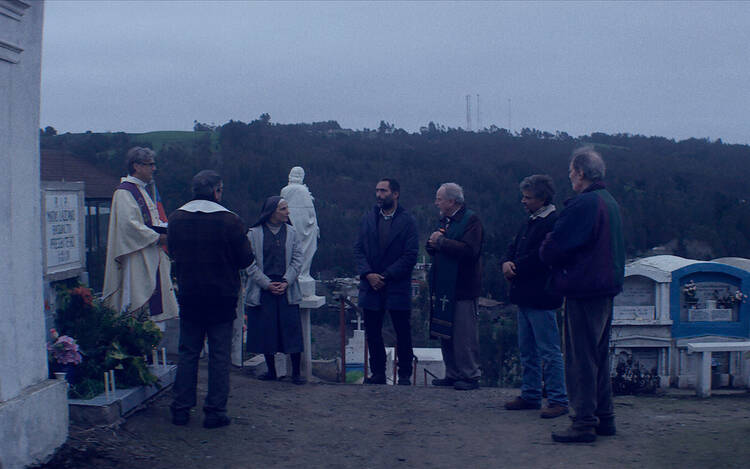My first reaction was to blame the projection booth, or the producer who wouldn’t spend enough on good film, or the director who hadn’t thought about basics like lighting, or maybe even my failing eyesight. Where was the light, where was the color? Had it been filmed in an evening sandstorm or with grey gauze over the lens?
But no, director Pablo Larrain knew what he was doing. “The Club” is the story of spiritual darkness, clouded minds, of sunset in miserable lives, of violence and piety. Of pedophiles, men loathed, but still human beings, trapped in a gnawing guilt they stubbornly deny. They are Catholic priests.
Four middle-aged to elderly priests have been sentenced to a house on the remote coast of Chili overlooking a little fishing village, with a nun, Sister Monica, to both feed and supervise them, march them through their daily schedule of breviary, Mass, rosary and hymns and remind them they may not approach townspeople except at approved times.
Their one shared release is to train a brown greyhound to race in local contests, with a dream of winning a state final.
Their lives change radically with the arrival of another priest, Father Lazcano, an arrogant bearded man, like the rest of them in denial of his offenses. But a local fisherman, Sandokan, recognizes him as a priest who sexually abused him years ago and, determined on revenge, plants himself outside the house and screams the priest’s sins in brutal detail, for all to hear. We see a pistol. Bang! Father Lazcano is dead. The parable has become a crime story.
Now another very different priest invades this world, Father Garcia, a crisis counselor, a Jesuit psychologist delegated to write a report. About what? Is the church closing their home? Father Garcia, tall, good-looking, tightly controlled, represents another side of the church, its power and authority. Whether he represents its heart, we shall see.
He interviews them one by one, determined to break the walls that seal off their guilt. Some deny that acting out their homosexuality has been sinful. One is a former army chaplain, another is senile. Another has abducted babies from unwed mothers—for their own good, of course. When Father Garcia asks one, the dog trainer, why he has a dog, the priest replies frankly: “For affection.” Father Garcia orders him to replace it with a cat. He tightens the rules—no more wine, much less meat, more isolation and prayer.
The men grumble. He lashes back. “The church” has sent him to disciple these vulnerable men. He shouts: “I am the church!” What does the director mean by implanting these words in the Jesuit? Does the Jesuit represent a brutal church to the viewers, or is he a frustrated father snapping at his children?
All of these men and their one woman represent various aspects of the church today as it takes a hard look at itself and confesses its sins; despite the punishment of thousands of offenders, the church remains crippled, says this film, by the arrogance of Adam and Eve and the violence of Cain.
The only bright color in the film breaks through in a final brief blazing sunset over the ocean. As we left the preview showing I asked another critic what he thought. He replied: “It is the most depressing thing I have ever seen in my life.” Another critic called it a comedy. A German writer suggested that “It is no stretch to imagine the picture becoming compulsory viewing for all bishops across the planet.” The final words appear on the dark screen: “Lamb of God who takes away the sins of the world, grant us peace.”








